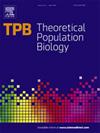基于遗传标记数据的群体结构分析的Patterson-Price-Reich规则。
IF 1.3
4区 生物学
Q4 ECOLOGY
引用次数: 0
摘要
从个体样本的标记基因型描绘种群结构现在在分子生态学、进化和保护生物学等领域经常进行。已经提出了各种贝叶斯和似然方法以及更一般的统计方法(例如PCA)来检测种群结构,将采样个体分配到离散集群(亚种群),并估计每个采样个体的混合比例。无论采用何种方法,结构分析的能力取决于群体结构的强度(通过FST测量)相对于标记信息的数量(通过NL测量,其中N和L分别是采样个体和位点的数量)。Patterson, Price和Reich(2006)提出,当数据量D = NL小于1/FST2时,群体结构是无法识别的,当D bbbb1 /FST2时,随着D或FST的增加,群体结构很快就容易识别了。在本研究中,我通过四种似然混合分析方法对模拟基因组数据和经验数据进行分析,研究了小反刍兽疫的相变规律。结果表明,PPR规则在很大程度上是有效的,但结构分析的准确性也受到K亚群数量的影响。K越大,越复杂的群体结构需要更大的NLFST2才能准确解析。当NLFST2大于PPR阈值1时,增加L和减少N比增加N和减少L更有利于提高外加剂估计精度。本文章由计算机程序翻译,如有差异,请以英文原文为准。
The Patterson-Price-Reich's rule of population structure analysis from genetic marker data
Delineating population structure from the marker genotypes of a sample of individuals is now routinely conducted in the fields of molecular ecology, evolution and conservation biology. Various Bayesian and likelihood methods as well as more general statistical methods (e.g. PCA) have been proposed to detect population structure, to assign sampled individuals to discrete clusters (subpopulations), and to estimate the admixture proportions of each sampled individual. Regardless of the methods, the power of a structure analysis depends on the strength of population structure (measured by FST) relative to the amount of marker information (measured by NL, where N and L are the numbers of sampled individuals and loci respectively). Patterson, Price and Reich (2006) proposed that population structure is unidentifiable when data size D = NL is smaller than and quickly becomes identifiable easily with an increasing D or FST when . In this study, I investigated this phase change PPR rule by analysing both simulated genomic data and empirical data by four likelihood admixture analysis methods. The results show that the PPR rule is largely valid, but the accuracy of a structure analysis is also affected by the number of subpopulations K. A more complicated population structure with a larger K requires a larger to resolve accurately. For a given above the PPR threshold value of 1, increasing L and decreasing N is advantageous over increasing N and decreasing L in improving admixture estimation accuracy.
求助全文
通过发布文献求助,成功后即可免费获取论文全文。
去求助
来源期刊

Theoretical Population Biology
生物-进化生物学
CiteScore
2.50
自引率
14.30%
发文量
43
审稿时长
6-12 weeks
期刊介绍:
An interdisciplinary journal, Theoretical Population Biology presents articles on theoretical aspects of the biology of populations, particularly in the areas of demography, ecology, epidemiology, evolution, and genetics. Emphasis is on the development of mathematical theory and models that enhance the understanding of biological phenomena.
Articles highlight the motivation and significance of the work for advancing progress in biology, relying on a substantial mathematical effort to obtain biological insight. The journal also presents empirical results and computational and statistical methods directly impinging on theoretical problems in population biology.
 求助内容:
求助内容: 应助结果提醒方式:
应助结果提醒方式:


